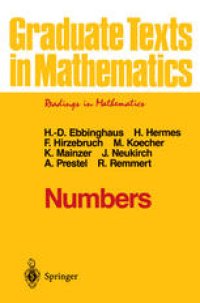
Ebook: Numbers
- Tags: Number Theory
- Series: Graduate Texts in Mathematics 123
- Year: 1991
- Publisher: Springer-Verlag New York
- Edition: 1
- Language: English
- pdf
A book about numbers sounds rather dull. This one is not. Instead it is a lively story about one thread of mathematics-the concept of "number" told by eight authors and organized into a historical narrative that leads the reader from ancient Egypt to the late twentieth century. It is a story that begins with some of the simplest ideas of mathematics and ends with some of the most complex. It is a story that mathematicians, both amateur and professional, ought to know. Why write about numbers? Mathematicians have always found it diffi cult to develop broad perspective about their subject. While we each view our specialty as having roots in the past, and sometimes having connec tions to other specialties in the present, we seldom see the panorama of mathematical development over thousands of years. Numbers attempts to give that broad perspective, from hieroglyphs to K-theory, from Dedekind cuts to nonstandard analysis.
This is a book about numbers - all kinds of numbers, from integers to p-adics, from rationals to octonions, from reals to infinitesimals. Who first used the standard notation for ?? Why was Hamilton obsessed with quaternions? What was the prospect for "quaternionic analysis" in the 19th century? This is the story about one of the major threads of mathematics over thousands of years. It is a story that will give the reader both a glimpse of the mystery surrounding imaginary numbers in the 17th century and also a view of some major developments in the 20th.
This is a book about numbers - all kinds of numbers, from integers to p-adics, from rationals to octonions, from reals to infinitesimals. Who first used the standard notation for ?? Why was Hamilton obsessed with quaternions? What was the prospect for "quaternionic analysis" in the 19th century? This is the story about one of the major threads of mathematics over thousands of years. It is a story that will give the reader both a glimpse of the mystery surrounding imaginary numbers in the 17th century and also a view of some major developments in the 20th.
Content:
Front Matter....Pages i-xviii
Introduction....Pages 1-6
Front Matter....Pages 7-7
Natural Numbers, Integers, and Rational Numbers....Pages 9-26
Real Numbers....Pages 27-53
Complex Numbers....Pages 55-96
The Fundamental Theorem of Algebra....Pages 97-122
What is ??....Pages 123-153
The p-Adic Numbers....Pages 155-178
Front Matter....Pages 179-179
Introduction....Pages 181-182
Repertory. Basic Concepts from the Theory of Algebras....Pages 183-187
Hamilton’s Quaternions....Pages 189-220
The Isomorphism Theorems of Frobenius, Hopf and Gelfand—Mazur....Pages 221-247
Cayley Numbers or Alternative Division Algebras....Pages 249-264
Composition Algebras. Hurwitz’s Theorem—Vector-Product Algebras....Pages 265-280
Division Algebras and Topology....Pages 281-302
Front Matter....Pages 303-303
Nonstandard Analysis....Pages 305-327
Numbers and Games....Pages 329-353
Set Theory and Mathematics....Pages 355-379
Back Matter....Pages 381-398
This is a book about numbers - all kinds of numbers, from integers to p-adics, from rationals to octonions, from reals to infinitesimals. Who first used the standard notation for ?? Why was Hamilton obsessed with quaternions? What was the prospect for "quaternionic analysis" in the 19th century? This is the story about one of the major threads of mathematics over thousands of years. It is a story that will give the reader both a glimpse of the mystery surrounding imaginary numbers in the 17th century and also a view of some major developments in the 20th.
Content:
Front Matter....Pages i-xviii
Introduction....Pages 1-6
Front Matter....Pages 7-7
Natural Numbers, Integers, and Rational Numbers....Pages 9-26
Real Numbers....Pages 27-53
Complex Numbers....Pages 55-96
The Fundamental Theorem of Algebra....Pages 97-122
What is ??....Pages 123-153
The p-Adic Numbers....Pages 155-178
Front Matter....Pages 179-179
Introduction....Pages 181-182
Repertory. Basic Concepts from the Theory of Algebras....Pages 183-187
Hamilton’s Quaternions....Pages 189-220
The Isomorphism Theorems of Frobenius, Hopf and Gelfand—Mazur....Pages 221-247
Cayley Numbers or Alternative Division Algebras....Pages 249-264
Composition Algebras. Hurwitz’s Theorem—Vector-Product Algebras....Pages 265-280
Division Algebras and Topology....Pages 281-302
Front Matter....Pages 303-303
Nonstandard Analysis....Pages 305-327
Numbers and Games....Pages 329-353
Set Theory and Mathematics....Pages 355-379
Back Matter....Pages 381-398
....